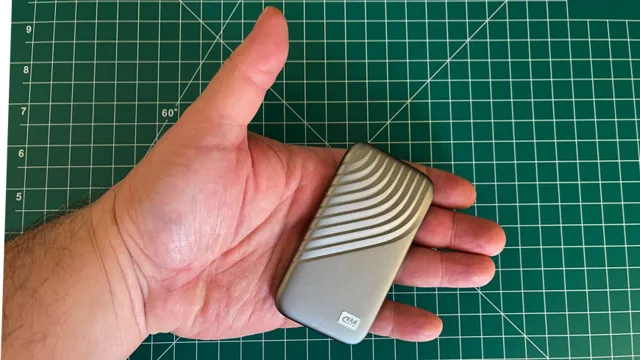Do you have a slow or malfunctioning external SSD? It’s time to consider reformatting it! Sometimes the storage device can become corrupt, leading to issues with data transfer and overall performance. Reformatting can help to restore its functionality and give it a fresh start. In this blog, we’ll cover the reasons why you might need to reformat your external SSD, the steps involved, and some best practices to ensure a smooth and successful process.
So, grab your external SSD and let’s dive in!
What is an external SSD?
If you’re wondering how long it takes to reformat an external SSD, the answer will vary depending on the size of the drive and the speed of your computer. Typically, the process shouldn’t take more than a few minutes. But it’s important to note that formatting an SSD can also depend on the type of file system you’re using.
For instance, if you’re formatting your external SSD for use with a Mac, you’ll need to choose the HFS+ file system. If you’re formatting for use with a Windows computer, the NTFS file system is the standard. This will impact the length of time it takes to format your drive.
It’s also worth noting that formatting your external SSD will erase all data on the drive, so it’s important to make sure you’ve backed up any important files beforehand.
Explaining SSDs and their usage as external devices
An external SSD refers to a storage device that connects to a computer or other devices through a USB port or Thunderbolt port. SSD stands for Solid State Drive, and it’s different from the traditional hard drive because it has no moving parts. Meaning, data is stored on flash memory chips, and this enables faster read and write speeds.
External SSDs are perfect for transferring files between devices, backup storage, and providing extra storage space. They are small, portable, and lightweight, and you can store large amounts of data on them. With an external SSD, you can store your documents, photos, videos, and media files in one place without worrying about running out of space.
It’s like having a portable file cabinet that you can take with you. Overall, an external SSD is an excellent investment for anyone who needs extra storage space or wants to have a fast and reliable way to transfer files between devices.

Factors affecting reformatting time
Reformatting an external SSD may take some time, and there are several factors that can affect the process. It’s essential to understand these variables to estimate how long it might take to reformat an external SSD successfully. Among these considerations are the size of the drive, the speed of the computer, the type of file system used, and whether any errors are detected during the process.
The larger the drive, the longer it will take to reformat, so it’s essential to plan accordingly. The speed of the computer also plays a role, as faster processors and newer hardware will reduce the time required to complete the process. Finally, the file system used can also impact how long it takes to reformat the drive.
Different file systems have different levels of complexity, which can contribute to longer wait times. Regardless of the specific circumstances, taking the time to assess these variables will provide a clearer understanding of how long it will take to reformat an external SSD.
Disk size, type of formatting, computer speed, and other factors that affect the process
Reformatting a computer can take a varying amount of time depending on different factors. One of the most significant ones is disk size. If the hard drive is large, it will take longer to reformat.
The type of formatting chosen can also impact the process. Quick formatting is faster than full formatting, but full formatting is more thorough. Computer speed is another factor.
A faster computer will complete the process more quickly. Additionally, the amount of data on the drive affects the time it takes to reformat. If there is a lot of data, it will take longer to format the drive.
Lastly, whether the computer is equipped with an SSD or an HDD can impact the process. SSDs are faster and more efficient, resulting in a faster reformatting process. When reformatting a computer, it’s essential to consider these factors to estimate how long the process will take.
Knowing this information can help one to plan for the time needed and avoid any surprises or frustrations along the way.
Average reformatting time
If you’re wondering how long it takes to reformat your external SSD, the answer is it depends. The average reformatting time varies based on the size of the drive and the type of formatting you choose. For example, if you’re reformatting a 1TB SSD using the standard Quick Format option in Windows, it can take roughly 5-10 minutes.
However, if you’re using the Full Format option, it can take several hours to complete. It’s important to note that reformatting your external SSD will wipe all the data on the drive, so make sure you have a backup before proceeding. Additionally, some SSDs may require firmware updates or other maintenance tasks before reformatting, so it’s always a good idea to consult the manufacturer’s instructions prior to starting the process.
Overall, the time it takes to reformat your external SSD will vary, but by considering the size of the drive and the formatting option you choose, you can estimate how long the process will take.
Measuring the average duration of the process on different devices and under various conditions
As technology advances, the need to work on different devices with varying conditions increases. One of the most inconvenient tasks that we encounter is the reformatting of a device, be it a smartphone or a computer. The time it takes to complete this process is crucial in determining whether our work will be paused or if we can finish it in a timely manner.
So, what is the average reformatting time for devices? Well, it depends on the device and the conditions under which it is being formatted. For example, reformatting a laptop with heavy software and a large amount of data might take longer than a smartphone with lesser data. Factors like the speed of the device, the efficiency of the software used, and the amount of data being reformatted all play a role in determining the duration of the process.
However, based on a general average, the reformatting time for a device usually ranges from 30 minutes to an hour. It may take longer, or it could be quicker, depending on the aforementioned factors. The takeaway is that reformatting is an essential task that comes with a time cost, and it is important to ensure that the device is reformatted correctly to avoid any technical difficulties in the future.
Tips for faster reformatting
If you’re wondering how long it takes to reformat an external SSD, the answer is it really depends on the size of your drive and the method you’re using to reformat it. However, there are ways to speed up the process so you’re not waiting around all day. One thing you can do is to make sure you have the latest firmware for your drive, as this can improve performance.
Another tip is to use a quick format instead of a full format, as this will save time but may not be as thorough. You can also try using a specialized disk utility program, which can help optimize the formatting process. Lastly, it’s important to make sure you have a reliable power source and that you’re not using your computer for other tasks while reformatting, as this can slow down the process.
Overall, reformatting an external SSD shouldn’t take too long if you follow these tips and have a bit of patience.
Optimizing computer performance and utilizing formatting tools to speed up the process
If you’re looking for ways to speed up the reformatting process on your computer and optimize its performance, then you’re in the right place. Formatting can be a tedious and time-consuming task, especially if you have a lot of files to format. But with a few optimization tricks and tools, you can minimize the time spent on reformatting and get your computer running faster.
One of the best ways to speed up reformatting is by using keyboard shortcuts rather than navigating menus with your mouse. You can save a lot of time by learning a few of these shortcuts, and the process will become much more efficient. Another tip is to use formatting templates to automate the formatting process.
Not only will using templates save time, but it will also ensure that all your documents follow the same formatting guidelines. Lastly, regularly cleaning up your computer’s hard drive and deleting unnecessary files can significantly improve your computer’s performance. By implementing these tips and tricks, your reformatting process will become much faster, saving you time and boosting your productivity.
Conclusion
In the grand scheme of things, the time it takes to reformat your external SSD is just a mere blip on the radar of life. But, like a finely tuned magician, the speed and efficiency with which you perform this feat can make all the difference. So take a deep breath, set your stopwatch, and let the techno-wizardry commence!”
Final thoughts and recommendations for efficient reformatting of external SSDs
When it comes to reformatting external SSDs, there are a few things you can do to speed up the process. Firstly, consider using a tool designed specifically for reformatting, as it can often streamline the process and save time. Additionally, ensure that your SSD is properly connected to your computer and that you have the necessary permissions to perform the reformatting.
Another tip is to use a quick format instead of a full format, which can save time while still achieving the desired result. Lastly, be sure to back up any important data on the SSD before reformatting to prevent any loss in case something goes wrong. By following these tips, you can ensure efficient and successful reformatting of your external SSD.
FAQs
1. How long does it typically take to reformat an external SSD? A: The time it takes to reformat an external SSD varies depending on factors such as the size of the drive and the speed of your computer. However, it usually takes anywhere from a few minutes to an hour. 2. Can I use my computer while reformatting my external SSD? A: It is generally not recommended to use your computer while reformatting an external SSD as it can slow down the process and potentially cause data corruption. It is best to let the formatting process complete before using your computer again. 3. What is the difference between quick format and full format for an external SSD? A: Quick format only erases the file system of the external SSD, while a full format erases all data on the drive and checks for bad sectors. A full format takes longer but is recommended if you want to completely wipe the drive before using it again. 4. Can I reformat my external SSD without losing my data? A: Unfortunately, reformatting an external SSD will erase all data on the drive. It is important to make sure you have a backup of any important files before proceeding with the formatting process.
